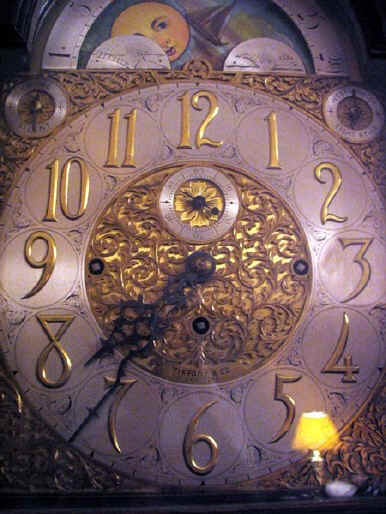|
The Grandfather Clock
By Jeff Figler
 Have
you ever walked into a house and heard majestical musical notes in the
background? You ask yourself where they are coming from. Then you
realize that the musical interlude might be coming from none other than
a grandfather clock. Have
you ever walked into a house and heard majestical musical notes in the
background? You ask yourself where they are coming from. Then you
realize that the musical interlude might be coming from none other than
a grandfather clock.
Kind of an unusual name for a clock. Where did they
originate? How was the name devised?
People have always searched for ways to keep track of
time, and have tried to improve on methods to accurately keep time.
Until the advent of mechanical clocks in medieval Europe, the methods to
track time include sundials, also called shadow clocks, the hourglass,
water powered devices called clepsydras, and candles.
The first mechanical clocks were developed during the
second half of the 13th century, most likely by European
monks. These clocks were made of heavy iron frames and gears, and did
not have any dials or arms. They were often placed in the church tower
and only struck bells on the hour by using the existing church bell.
Later, an hour hand was added to the mechanical clocks, and other
enhancements were devised allowing the clock to strike every quarter
hour. By the 15th century, small domestic clocks had been
made. After the 1630s, a weight-driven timepiece called the lantern
clock became popular in some homes of upper class families.
 But
it was Galileo who conceived of the major breakthrough in clock making.
In 1582 he discovered that a pendulum could be used to keep time. In
1656 the Dutch scientist Huygens developed the first pendulum clock. The
clock became the prototype for the modern grandfather clock. The first
pendulum clocks were referred to as "wags-on-the-wall" at the
time, had short pendulums and were hung on a wall. These clocks were
often encased in wood, such as grandfather clocks of today. Clocks
devised by the invention of Huygens were so accurate that often there
was only a loss or gain of a few minutes a day. But
it was Galileo who conceived of the major breakthrough in clock making.
In 1582 he discovered that a pendulum could be used to keep time. In
1656 the Dutch scientist Huygens developed the first pendulum clock. The
clock became the prototype for the modern grandfather clock. The first
pendulum clocks were referred to as "wags-on-the-wall" at the
time, had short pendulums and were hung on a wall. These clocks were
often encased in wood, such as grandfather clocks of today. Clocks
devised by the invention of Huygens were so accurate that often there
was only a loss or gain of a few minutes a day.
By 1660 English clockmakers took Huygens’ design
and introduced clocks with 6 feet long cases and ten-inch pendulums. In
1670, with the use of a pendulum that was slightly over 39 inches, now
called the Royal Pendulum, Robert Hook and William Clement created the
grandfather clock. It measured over 7 feet from the floor. Handles for
the minutes were soon added. Clocks became encased with glass to show
the pendulum and weights. These clocks, now called grandfather clocks,
were called long case clocks, or floor clocks, until the 1880s.
The golden age of long case clocks was between 1630
and 1730, and they were first made for royal families and nobles.
However, production costs were cut down, and by 1685 long case clocks
were imported into the American colonies.
 The
term "grandfather clock" for long case or floor clocks became
widespread in England and America thanks to a song composed by Henry
Work in 1875. Work, an American songwriter, composed "Grandfather’s
Clock", about an old floor clock that stood in the lobby of the
George Hotel in Piercebridge, North Yorkshire, England. The name stuck. The
term "grandfather clock" for long case or floor clocks became
widespread in England and America thanks to a song composed by Henry
Work in 1875. Work, an American songwriter, composed "Grandfather’s
Clock", about an old floor clock that stood in the lobby of the
George Hotel in Piercebridge, North Yorkshire, England. The name stuck.
There have been many improvements on keeping time,
including ones to pendulums. However, nothing seems to replace the
stately appearance of a grandfather clock that stands between 6 ½ feet
– 8 feet tall. They are an object of beauty, and an impressive symbol
of the passage of time.
Naturally, collectors are aware of how well old
grandfather clocks are. The vintage clocks are very collectible, despite
sometimes the costly shipping charges.
A few examples of auction sales of grandfather clocks
include the following:
In 2014 a George II Quarter-Striking Tall Case Clock
sold for $17,500. However, a Tiffany grandfather clock with a 9-bell,
Westminster and Whittington melody, sold for $50,000, while an extremely
ornate figural carved oak 9 Tube grandfather clock sold for $80,000.
So it is very clear that the value of grandfather
clocks can run the spectrum, often depending on how ornate they are. |